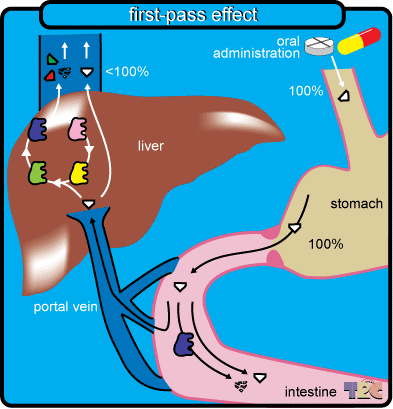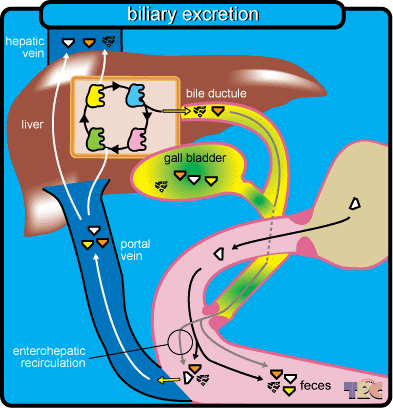Pharmacokinetics – ADME
Metabolism
Definition: also known as xenobiotic metabolism is the biochemical modification of pharmaceutical substances or xenobiotics respectively by living organisms, usually through specialized enzymatic systems. Drug metabolism often converts lipophilic chemical compounds into more readily excreted hydrophilic products.
- Two Main options:
- excreted unchanged
- metabolised then excreted
- Three aspects of metabolism:
- activation of inactive drug
- production of active drug from active drug
- inactivation of active drugs
Phases of Metabolism
- Phase I reactions
- Oxidation, reduction and hydrolysis
- Usually form more reactive products, sometimes toxic
- Often involve mixed function oxidase system in which Cytochrome P450 plays a key role
- Phase II reactions
- Conjugation
- Usually form inactive and readily excretable products
What are the factors affecting drug metabolism?
Drug metabolism can be affected by:
- First pass effect
- Hepatic blood flow
- Liver disease
- Drugs which alter liver enzymes
- Genetic factors e.g. acetylation status
- Other drugs hepatic enzyme inducers hepatic enzyme inhibitors
- Age - Impaired hepatic enzyme activity • Elderly • Children < 6 months (especially premature babies)
Enzyme Inducing Drugs
- Enhance the production of liver enzymes which break down drugs
- Faster rate of drug breakdown
- Larger dose of affected drug needed to get the same clinical effect
| Phenytoin | Griseofulvin |
| Phenobarbitone | Chronic alcohol intake |
| Carbamazepine | Smoking |
| Rifampicin |
Enzyme Inhibiting Drugs
- Inhibit the enzymes which break down drugs
- Decreased rate of drug breakdown
- Smaller dose of affected drug needed to produce the same clinical effect
| Ciprofloxacin | Metronidazole |
| Chloramphenicol | Sulphonamides |
| Acute alcohol | Allopurinol |
| Phenylbutazone | Isoniazid |
| Oral contraceptives | Sodium valproate |
| Cimetidine | Omeprazole |
| Calcium channel blockers | Amiodarone |
| Dextropropoxyphene | Fluconazole |
| Erythromycin |
First Pass Metabolism
Drugs absorbed from GI tract pass into the blood stream
Blood travels IMMEDIATELY to the liver
Some drugs are inactivated the first time they pass through the liver
Affects drug dose given by different routes:
- Example: Propranolol
- Example: GTN cannot be given orally except by by-passing the liver (S/L or buccal tablets)
If given IV, the dose is 1mg
If given PO, the dose is 40mg
Affects possible routes of administration
Diagram of first pass effect

Other issues
- Digoxin | erythromycin drug interaction
- In 10% of population, a substantial amount of digoxin is inactivated by bacteria in the large intestine.
- Erythromycin kills bacteria which inactivate the drug.
- More active drug reabsorbed
- Therefore risk of digoxin toxicity
Diagram of entero-hepatic circulation
1. Secreted bile salts consist of about 95% old, recycled bile salts and 5% newly synthesized bile salts
2. 95% of bile salts are reabsorbed by the small intestine
3. Reabsorbed bile salts are then recycled by the enterohepatic circulation

What is the significance of entero hepatic circulation?
Ethinylestradiol and antibiotics interaction
- Ethinylestradiol undergoes hepatic recirculation
- Conjugates are excreted in the bile
- Hydrolysed by bacteria in the colon releasing oestrogen which is reabsorbed with the bile
- Antibiotics prevent this and may result in contraceptive failure (Note: recent guidance has advised this is no longer considered clinically significant)
Copyright eBook 2019, University of Leeds, Leeds Institute of Medical Education.